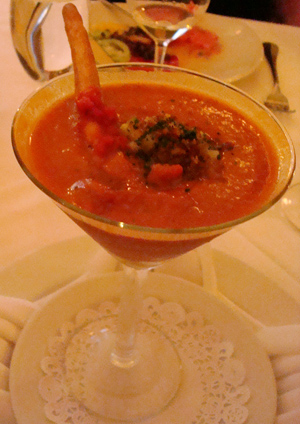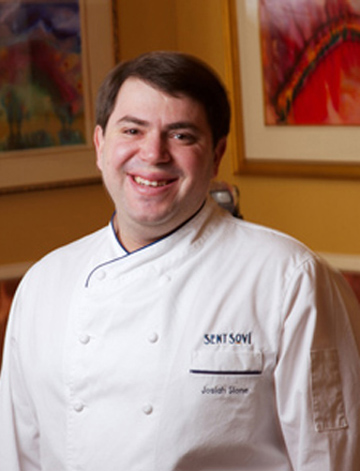Take Five with Sent Sovi’s Josiah Slone, Who Came Home to Forge Success
Josiah Slone’s story is that of a local boy done good. Born in San Francisco, and raised on the Peninsula, he had a pretty good idea even as a child that he wanted to be a chef one day.
You see, while other kids were watching Looney Toons, he was tuning into the cooking shows of Julia Child, Jacques Pepin and Martin Yan.
After stints in Santa Monica and Jamaica, the 31-year-old chef opened his first restaurant, Saratoga’s Sent Sovi in 2003, realizing his dream of having his own place in his home area.
I sat down with him to chat about the cookbook that changed his life, studying electrical engineering in college, and how everyone else — except him — felt the pressure when he bought Chef David Kinch’s famed Sent Sovi restaurant.
Q: You actually read the “The Joy of Cooking (Scribner) when you were a kid?
A: I looked through it when I was a really little kid, before I could read very well. It was this big book, and it had two red ribbons in it to mark your place. The old one had menus for bridge parties and afternoon tea. It reminded me of going to my grandma’s house.
I remember cooking out of it when I was in the 6th grade. I made meatloaf out of it, and cookies. It was my Mom’s go-to cookbook. We still have a copy of the “Joy of Cooking” in the kitchen at Sent Sovi. I also took “Joy of Cooking” to Jamaica with me.

Q: Did your Mom inspire you to cook?
A: (laughs) My Mom did cook. She likes to say “I taught him everything I know about cooking. It wasn’t very much.”
Q: You’re a Bay Area native. Do you think that’s also a reason why you’re so into food?
A: Growing up in Palo Alto was good. It had good restaurants even back then. I went to Ohlone Elementary School, which had a farm. We grew food. There were chickens and goats. Kids today know Ronald McDonald, but they don’t know where food comes from.
I was always fascinated by cooking as a kid. I’d go peek into the kitchen of the Chinese restaurant we always went to. I’d stand with my head up to the kitchen window.
Q: You studied electrical engineering at UCLA? During the boom of Silicon Valley, did you ever wish you had pursued that instead of cooking?
A: I studied it for 2 ½ years, then left college. My parents were like ex-hippies. As a teenager, I went to Wavy Gravy’s summer camp in Mendocino County. I’d juggle and unicycle. The camp was a hog farm, but you never saw any pigs there. Instead of going to classes, I’d go help out in the kitchen instead.
I was in Jamaica when Silicon Valley really boomed. Engineering is a perfectly noble profession, but it wasn’t for me. I’m really into science, and technology really influences what I do. The chemistry and physics of food I use all the time. It’s just another tool. It’s not the genesis of what I make, though.
Q: When Sent Sovi opened, did you feel the pressure of following in David Kinch’s celebrated footsteps?
A: No, I didn’t pay any attention to it. I’d been out of the country for 1 ½ years, then worked in casual dining for awhile. I didn’t feel much pressure about following the fine-dining scene back then.
Q: Some people thought you were crazy to keep the name of the restaurant. You never thought about changing it?
A: Nope. I liked the name.

Q: What’s the best and worst part about having your own restaurant?
A: The best and the worst part is that you can do whatever you want to do. The best part is I can do the cuisine I want to do. The worst part is instead of being able to focus solely on food or just service, there are a lot more things about running a business that you have to focus on. I’d rather be in the kitchen all day, every day. But some days, I have to take care of business.
Q: Your wife, a tax accountant who manages the restaurant, is Burmese. Does her native cuisine at all play into what you do at Sent Sovi?
A: In subtle ways. Like the foie gras soup. One of the garnishes is crispy yellow peas. My mother-in-law told me how to take the dried peas, soak them with baking soda and water, then fry them. They taste like homemade corn nuts. I’ve been to Burma. The cuisine is phenomenal. I use a lot of allspice from my time in Jamaica. I use it like black pepper.
Q: Whom do you admire?
A: I have tremendous respect for Jacques Pepin and Julia Child. She took a lot of mystique away. Pepin is so focused on the fundamental techniques. If you learn them, you can make good food. And if you have imagination with that, you can make great food.
Q: In the past five years, are you happy with how the South Bay dining scene has evolved?
A: More good options for dining is better for everybody. I’d rather have people driving to the South Bay than feeling like they have to drive to San Francisco or Napa. There are some very good restaurants that have opened up — Manresa (Kinch’s subsequent restaurant), the Plumed Horse, Trevese, and Parcel 104.
But a lot of restaurants have run their course; they’re still doing things they did in the 1970s and 1980s. Believe me, I will retire long before I get to that point where my menu is the same thing year-round.

